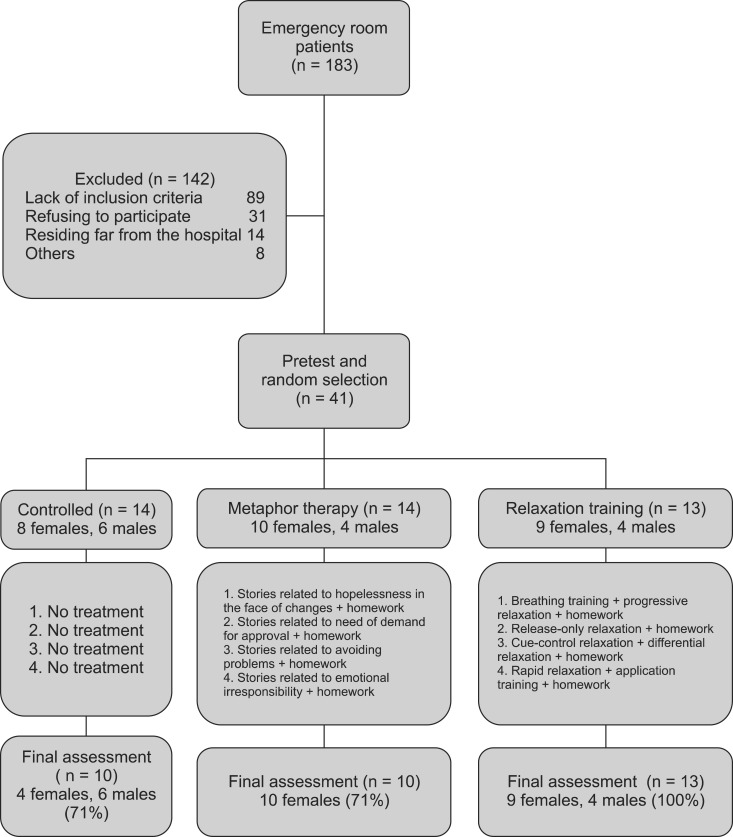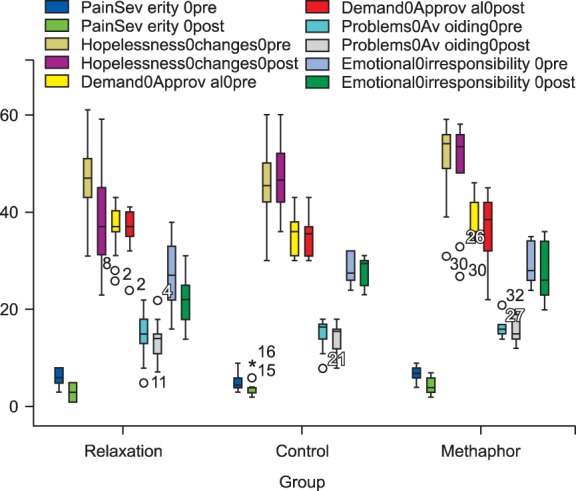Korean J Pain.
2015 Apr;28(2):88-95. 10.3344/kjp.2015.28.2.88.
Reducing Irrational Beliefs and Pain Severity in Patients Suffering from Non-Cardiac Chest Pain (NCCP): A Comparison of Relaxation Training and Metaphor Therapy
- Affiliations
-
- 1Interventional Cardiologist, Assistant Professor at Kermanshah University of Medical Sciences, Kermanshah, Iran.
- 2Cardiac Anesthesiologist, Assistant Professor at Kermanshah University of Medical Sciences, Imam Ali Hospital, University of Medical Sciences, Kermanshah, Iran.
- 3Master of Clinical Psychology, Cardiac Rehabilitation Center, Imam Ali Hospital, Kermanshah University of Medical Sciences, Kermanshah, Iran.
- 4Pharmacy Student at Kermanshah University of Medical Sciences, Kermanshah, Iran.
- 5Master of Clinical Psychology, Cardiac Rehabilitation Center, Imam Ali Hospital, Kermanshah University of Medical Sciences, Kermanshah, Iran. S_komasi63@yahoo.com
- KMID: 2278265
- DOI: http://doi.org/10.3344/kjp.2015.28.2.88
Abstract
- BACKGROUND
Patients suffering from non-cardiac chest pain (NCCP) can interpret their chest pain wrongly despite having received a correct diagnosis. The objective of this study was to compare the efficacy of the relaxation method with metaphor therapy for reducing irrational beliefs and pain severity in patients with NCCP.
METHODS
Using a randomized controlled trial, 33 participants were randomly divided into a relaxation training group (n= 13), a metaphor therapy group (n = 10), and a control group (n = 10), and were studied for 4 weeks. The two tools used in this research were the Brief Pain Inventory (BPI) index for determining the degree of pain and the short version of the Jones Irrational Belief Test. Metaphor therapy and a relaxation technique based on Ost's treatment were used as the interventions. The collected data were analyzed with a multivariate analysis of covariance (MANCOVA), a Chi-square test, and the Bonferroni procedure of post-hoc analysis.
RESULTS
The relaxation training method was significantly more effective than both metaphor therapy and the lack of treatment in reducing the patients' beliefs of hopelessness in the face of changes and emotional irresponsibility, as well as the pain severity. Metaphor therapy was not effective on any of these factors. In fact, the results did not support the effectiveness of metaphor therapy.
CONCLUSIONS
Regarding the effectiveness of the relaxation method as compared with metaphor therapy and the lack of treatment in the control group, this study suggests that relaxation should be paid greater attention as a method for improving the status of patients. In addition, more studies are needed to determine the effectiveness of metaphor therapy in this area.
Keyword
Figure
Cited by 1 articles
-
Irrational beliefs predict pain/discomfort and emotional distress as a result of pain in patients with non-cardiac chest pain
Saeid Komasi, Ali Soroush, Mostafa Bahremand, Mozhgan Saeidi
Korean J Pain. 2016;29(4):277-279. doi: 10.3344/kjp.2016.29.4.277.
Reference
-
1. Fass R, Navarro-Rodriguez T. Noncardiac chest pain. J Clin Gastroenterol. 2008; 42:636–646. PMID: 18364579.
Article2. Galmiche JP, Clouse RE, Bálint A, Cook IJ, Kahrilas PJ, Paterson WG, et al. Functional esophageal disorders. Gastroenterology. 2006; 130:1459–1465. PMID: 16678559.
Article3. Kontos MC, Diercks DB, Kirk JD. Emergency department and office-based evaluation of patients with chest pain. Mayo Clin Proc. 2010; 85:284–299. PMID: 20194155.
Article4. Jones MP, Venketesan T, Wulsin LR. Evaluation of noncardiac chest pain: toward a positive diagnosis. Hosp Physician. 2000; 36:54–69.5. Eslick GD, Jones MP, Talley NJ. Non-cardiac chest pain: prevalence, risk factors, impact and consulting--a population-based study. Aliment Pharmacol Ther. 2003; 17:1115–1124. PMID: 12752348.
Article6. Bringager CB. A prospective follow-up study of chest pain patients - with emphasis on patients with panic disorder (Doctoral dissertation). Oslo: University of Oslo;2007.7. Chignon JM, Lepine JP, Ades J. Panic disorder in cardiac outpatients. Am J Psychiatry. 1993; 150:780–785. PMID: 8386907.
Article8. Bass C, Mayou R. Chest pain. BMJ. 2002; 325:588–591. PMID: 12228139.9. Barsky AJ, Cleary PD, Coeytaux RR, Ruskin JN. The clinical course of palpitations in medical outpatients. Arch Intern Med. 1995; 155:1782–1788. PMID: 7654112.
Article10. Bringager CB, Friis S, Arnesen H, Dammen T. Nine-year follow-up of panic disorder in chest pain patients: clinical course and predictors of outcome. Gen Hosp Psychiatry. 2008; 30:138–146. PMID: 18291295.
Article11. Jerlock M, Gaston-Johansson F, Danielson E. Living with unexplained chest pain. J Clin Nurs. 2005; 14:956–964. PMID: 16102147.
Article12. Donkin L, Ellis CJ, Powell R, Broadbent E, Gamble G, Petrie KJ. Illness perceptions predict reassurance following a negative exercise stress testing result. Psychol Health. 2006; 21:421–430.
Article13. McDonald IG, Daly J, Jelinek VM, Panetta F, Gutman JM. Opening Pandora's box: the unpredictability of reassurance by a normal test result. BMJ. 1996; 313:329–332. PMID: 8760739.
Article14. Webster RA. Psychological distress in non-cardiac chest pain patients: an application of the common sense model of illness representations (Doctoral dissertation). Sheffield: University of Sheffield;2012.15. Cheng C, Wong WM, Lai KC, Wong BC, Hu WH, Hui WM, et al. Psychosocial factors in patients with noncardiac chest pain. Psychosom Med. 2003; 65:443–449. PMID: 12764218.
Article16. Van Peski-Oosterbaan AS, Spinhoven P, Van Rood Y, Van der Does WA, Bruschke AJ. Cognitive behavioural therapy for unexplained non-cardiac chest pain: a pilot study. Behav Cogn Psychother. 1997; 25:339–350.
Article17. DeGuire S, Gevirtz R, Hawkinson D, Dixon K. Breathing retraining: a three-year follow-up study of treatment for hyperventilation syndrome and associated functional cardiac symptoms. Biofeedback Self Regul. 1996; 21:191–198. PMID: 8805966.
Article18. Achem SR. Noncardiac chest pain-treatment approaches. Gastroenterol Clin North Am. 2008; 37:859–878. ixPMID: 19028322.
Article19. Mirzamani SM, Sadidi A, Salimi SH, Besharat MA. Validation of the persian version of the brief pain inventory. Acta Med Iranica. 2005; 43:425–428.20. Ebadi GH, Motamedin M. The study of factorial structure of Jones irrational beliefs questionnaire in Ahvaz city. Knowl Res Psychol. 2005; 23:73–92.21. Potts SG, Lewin R, Fox KA, Johnstone EC. Group psychological treatment for chest pain with normal coronary arteries. QJM. 1999; 92:81–86. PMID: 10209659.
Article22. Carroll D, Seers K. Relaxation for the relief of chronic pain: a systematic review. J Adv Nurs. 1998; 27:476–487. PMID: 9543032.
Article23. Castel A, Pérez M, Sala J, Padrol A, Rull M. Effect of hypnotic suggestion on fibromyalgic pain: comparison between hypnosis and relaxation. Eur J Pain. 2007; 11:463–468. PMID: 16889999.
Article24. Karami J, Komasi S, Maesoomi M, Saeedi M. Comparing the effectiveness of two methods of relaxation and interpersonal cognitive problem solving on decreasing anxiety and depression in cardiac rehabilitation patients. Urmia Med J. 2014; 25:298–308.25. Kwekkeboom KL, Gretarsdottir E. Systematic review of relaxation interventions for pain. J Nurs Scholarsh. 2006; 38:269–277. PMID: 17044345.
Article26. Esler JL, Bock BC. Psychological treatments for noncardiac chest pain: recommendations for a new approach. J Psychosom Res. 2004; 56:263–269. PMID: 15046961.27. Erickson MH, Rossi EL. The collected papers of Milton H. Erickson on hypnosis. New York (NY): Irvington;1980.28. Haley J. Uncommon therapy. The psychiatric techniques of Milton Erickson. New York (NY): W. W, Norton & Company;1973.29. Witztum E, van der Hart O, Friedman B. The use of metaphors in psychotherapy. J Contemp Psychother. 1988; 18:270–290.
Article30. Legowski T, Brownlee K. Working with metaphor in narrative therapy. J Fam Psychother. 2001; 12:19–28.
Article
- Full Text Links
- Actions
-
Cited
- CITED
-
- Close
- Share
- Similar articles
-
- Non-Coronary Patients with Severe Chest Pain Show More Irrational Beliefs Compared to Patients with Mild Pain
- Non-cardiac Chest Pain in Japan: Prevalence, Impact, and Consultation Behavior - A Population-based Study
- Irrational beliefs predict pain/discomfort and emotional distress as a result of pain in patients with non-cardiac chest pain
- The Role of Psychological Factors in Noncardiac Chest Pain of Esophageal Origin
- Role of Mixed Reflux and Hypomotility with Delayed Reflux Clearance in Patients with Non-cardiac Chest Pain



